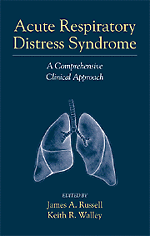Book contents
- Frontmatter
- Contributors
- Contents
- Preface
- Introduction
- 1 Overview, Clinical Evaluation, and Chest Radiology of ARDS
- 2 The Epidemiology of ARDS
- 3 The Pathology of ARDS
- 4 Cytokine -Induced Mechanisms of Acute Lung Injury Leading to ARDS
- 5 Pulmonary Pathophysiohgy in ARDS
- 6 Cardiovascular Management of ARDS
- 7 Mechanical Ventilation
- 8 Respiratory Muscles and Liberation from Mechanical Ventilation
- 9 Clinical Assessment and Total Patient Care
- 10 ARDS: Innovative Therapy
- 11 Nosocomial Pneumonia in ARDS
- 12 Resolution and Repair of Acute Lung Injury
- 13 Multiple System Organ Failure
- 14 Outcome and Long-Term Care of ARDS
- Index
4 - Cytokine -Induced Mechanisms of Acute Lung Injury Leading to ARDS
Published online by Cambridge University Press: 05 October 2010
- Frontmatter
- Contributors
- Contents
- Preface
- Introduction
- 1 Overview, Clinical Evaluation, and Chest Radiology of ARDS
- 2 The Epidemiology of ARDS
- 3 The Pathology of ARDS
- 4 Cytokine -Induced Mechanisms of Acute Lung Injury Leading to ARDS
- 5 Pulmonary Pathophysiohgy in ARDS
- 6 Cardiovascular Management of ARDS
- 7 Mechanical Ventilation
- 8 Respiratory Muscles and Liberation from Mechanical Ventilation
- 9 Clinical Assessment and Total Patient Care
- 10 ARDS: Innovative Therapy
- 11 Nosocomial Pneumonia in ARDS
- 12 Resolution and Repair of Acute Lung Injury
- 13 Multiple System Organ Failure
- 14 Outcome and Long-Term Care of ARDS
- Index
Summary
Introduction
As reported in Chapter 2, despite a number of important advances in mechanical ventilatory support, intensive care unit technology, and critical care training, the mortality due to complications of acute respiratory distress syndrome (ARDS) and/or multiorgan failure has not significantly changed during the past 20 years. The failure to fully advance new therapeutic schemes to treat patients with sepsis and ARDS likely reflects our limited knowledge regarding the basic mechanisms underlying these diseases. Thus, the ability to further diminish morbidity and increase survival requires an in-depth understanding of the important mediators involved in the evolution of these syndromes. This information could in turn provide clues as to what exogenous (microorganisms and their products) and endogenous (hostderived) factors should be targeted for modification or elimination during the various phases of sepsis leading to ARDS.
The pathogenesis of ARDS and multiorgan failure-complicating sepsis remains to be fully elucidated. However, polymicrobial agents, products derived from these microorganisms, and the subsequent host response to these factors are key determinants for the initiation and later perpetuation of organ injury. In fact, the host's own response to the initial challenge may be a more critical determinant to the outcome of sepsis and ARDS than the original inciting agent. This concept is supported by the findings that many of the multiple effects of bacterial-derived products, such as endotoxin and muramyl dipeptide, are largely indirect. These compounds exert their biologic effects in vivo by initiating a variety of mediator’ generating cascades, including coagulation and complement, vasoactive compounds, reactive oxygen and nitric oxide, arachidonic acid metabolites, and cytokines.
- Type
- Chapter
- Information
- Acute Respiratory Distress SyndromeA Comprehensive Clinical Approach, pp. 63 - 79Publisher: Cambridge University PressPrint publication year: 1999
- 1
- Cited by



